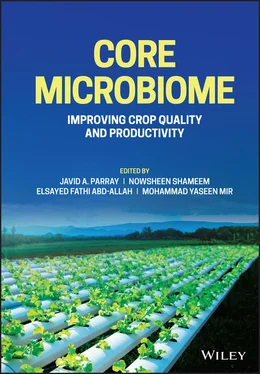19 19Morsy, N.M. (2014). Phytochemical analysis of biologically active constituents of medicinal plants. Main Group Chemistry 13: 7–21. DOI: 10.3233/MGC-130117
20 20Qi, X., Wang, E., Xing, M., Zhao, W., and Chen, X. (2012). Rhizosphere and non-rhizosphere bacterial community composition of the wild medicinal plant Rumex patientia. World Journal of Microbiology and Biotechnology 28: 2257–2265. DOI: 10.1007/s11274-012-1033-2
21 21Philippot, L., Raaijmakers, J.M., Lemanceau, P., and van der Putten, W.H. (2013). Going back to the roots: The microbial ecology of the rhizosphere. Nature Reviews Microbiology 11: 789–799. DOI: 10.1038/nrmicro3109
22 22Chaparro, J.M., Badri, D.V., and Vivanco, J.M. (2014). Rhizosphere microbiome assemblage is affected by plant development. The ISME Journal 8: 790–803. DOI: 10.1038/ismej.2013.196
23 23Egamberdieva, D., Berg, G., Lindstrom, K., and Rasanen, L. (2010). Root colonizing Pseudomonas spp. improve growth and symbiosis performance of fodder Galega (Galega orientalis LAM) grown in potting soil. European Journal of Soil Biology 46: 269–272. DOI: 10.1016/j.ejsobi.2010.01.005
24 24 Egamberdieva, D., Kucharova, Z., Davranov, K., Berg, G., Makarova, N., Azarova, T. et al. (2011). Bacteria able to control foot and root rot and to promote the growth of cucumber in salinated soils. Biology and Fertility of Soils 47: 197–205. DOI: 10.1007/s00374-010-0523-3
25 25 Malfanova, N., Kamilova, F., Validov, S., Shcherbakov, A., Chebotar, V., Tikhonovich, I. et al. (2011). Characterization of Bacillus subtilis HC8, a novel plant-beneficial endophytic strain from giant hogweed. Microbial Biotechnology 4: 523–532. DOI: 10.1111/j.1751-7915.2011.00253.x
26 26 Sessitsch, A., Kuffner, M., Kidd, P., Vangronsveld, J., Wenzel, W., Fallmann, K. et al. (2013). The role of plant-associated bacteria in the mobilization and phytoextraction of trace elements in contaminated soils. Soil Biology and Biochemistry 60: 182–194. DOI: 10.1016/j.soilbio.2013.01.012
27 27Berg, G., Grube, M., Schloter, M., and Smalla, K. (2014). Unraveling the plant microbiome: Looking back and future perspectives. Frontiers in Microbiology 5: 148. DOI: 10.3389/fmicb.2014.00148
28 28Köberl, M., Schmidt, R., Ramadan, E.M., Bauer, R., and Berg, G. (2014). The microbiome of medicinal plants: Diversity and importance for plant growth, quality and health. Frontiers in Microbiology 4: 400. DOI: 10.3389/fmicb.2013.00400
29 29Beneduzi, A., Ambrosini, A., and Passaglia, L.M.P. (2012). Plant growth-promoting rhizobacteria (PGPR): Their potential as antagonists and biocontrol agents. Genetics and Molecular Biology 35: 1044–1051. DOI: 10.1590/S1415-47572012000600020
30 30Weller, D.M., Raaijmakers, J.M., McSpadden Gardner, B.B., and Thomashow, L.S. (2002). Microbial populations responsible for specific soil suppressiveness to plant pathogens. Annual Review of Phytopathology 40: 308–348. DOI: 10.1146/annurev.Phyto.40.030402.110010
31 31Berendsen, R.L., Pieterse, C.M.J., and Bakker, P.A.H.M. (2012). The rhizosphere microbiome and plant health. Trends in Plant Science 17: 478–486. DOI: 10.1016/j.plants.2012.04.001
32 32Köberl, M., Ramadan, E.M., Adam, M., Cardinale, M., Hallmann, J., Heuer, H. et al. (2013). Bacillus and Streptomyces were selected as broad-spectrum antagonists against soilborne pathogens from arid areas in Egypt. FEMS microbiology letters 342: 168–178. DOI: 10.1111/1574-6968.12089
33 33Kumar, G., Kanaujia, N., and Bafana, A. (2012). Functional and phylogenetic diversity of root-associated bacteria of Ajuga bracteosa in Kangra valley. Microbiological Research 167: 220–225. DOI: 10.1016/j.micres.2011.09.001
34 34Hardoim, P.R., van Overbeek, L.S., Berg, G., Pirttilä, A.M., Compante, S., Campisano, A. et al. (2015). The hidden World within plants: Ecological and evolutionary considerations for defining functioning of microbial endophytes. Microbiology and Molecular Biology Reviews 79: 293–320. DOI: 10.1128/MMBR.00050-14
35 35Chandra, S. (2012). Endophytic fungi: Novel sources of anticancer lead molecules. Applied Microbiology and Biotechnology 95: 47–59. DOI: 10.1007/s00253-012-4128-7
36 36Pal, K.K. and McSpadden Gardener, B. (2006). Biological Control of Plant Pathogens. Plant Health Instr.
37 37Lecomte, C., Alabouvette, C., Edel-Hermann, V., Robert, F., and Steinberg, C. (2016). Biological control of ornamental plant diseases caused by Fusarium oxysporum: A review. Biological Control 101: 17–30.
38 38Eljounaidi, K., Lee, S.K., and Bae, H. (2016). Bacterial endophytes as potential biocontrol agents of vascular wilt diseases—Review and future prospects. Biological Control 103: 62–68.
39 39 Latz, M.A.C., Jensen, B., Collinge, D.B., and Jørgensen, H.J.L. (2018). Endophytic fungi as biocontrol agents: Elucidating mechanisms in disease suppression. Plant Ecology & Diversity 11: 555–567.
40 40 De Silva, N.I., Brooks, S., Lumyong, S., and Hyde, K.D. (2019). Use of endophytes as biocontrol agents. Fungal Biology Reviews 33: 133–148.
41 41 Morales-Cedeño, L.R., delCarmenOrozco-Mosqueda, M., Loeza-Lara, P.D., Parra-Cota, F.I., de losSantos-Villalobos, S., and Santoyo, G. (2021). Plant growth-promoting bacterial endophytes as biocontrol agents of pre-and post-harvest diseases: Fundamentals, methods of application and future perspectives. Microbiological Research 242: 126612.
42 42Santoyo, G., delOrozco-mosqueda, M.C., and Govindappa, M. (2012). Mechanisms of biocontrol and plant growth-promoting activity in soil bacterial species of Bacillus and Pseudomonas: A review. Biocontrol Science and Technology 22: 855–872.
43 43Dobbelaere, S., Vanderleyden, J., and Okon, Y. (2003). Plant growth-promoting effects of diazotrophs in the rhizosphere. Critical Reviews in Plant Sciences 22: 107–149.
44 44Gray, E.J. and Smith, D.L. (2005). Intracellular and extracellular PGPR: Commonalities and distinctions in the plant-bacterium signaling processes. Soil Biology and Biochemistry 37: 395–412.
45 45Schroth, M.N. and Hancock, J.G. (1982). Disease-suppressive soil and root-colonizing bacteria. Science 216: 1376–1381.
46 46Kloepper, J.W., Lifshitz, R., and Zablotowicz, R.M. (1989). Free-living bacterial inocula for enhancing crop productivity. Trends in Biotechnology 7: 39–43.
47 47Podile, A.R. and Kishore, G.K. (2006). Plant growth-promoting rhizobacteria. In: Plant-Associated Bacteria, (ed. S.S.Gnanamanickam), 195–230. Netherlands: Springer.
48 48Glick, B.R. (1995). The enhancement of plant growth by free-living bacteria. Canadian Journal of Microbiology 41: 109–117.
49 49Castronovo, L.M., Vassallo, A., Mengoni, A., Miceli, E., Bogani, P., Firenzuoli, F., Fani, R., and Maggini, V. (2021). Medicinal plants and their bacterial microbiota: A review on antimicrobial compounds production for plant and human health. Pathogens 10 (106). https://doi.org/10.3390/pathogens10020106
50 50Verma, V.C., Gond, S.K., Kumar, A., Kharwar, R.N., and Strobel, G. (2007). The endophytic mycoflora of bark, leaf, and stem tissues of Azadirachta indica A. Juss (Neem) from Varanasi (India). Microbial Ecology 54: 119–125.
51 51Verma, V.C., Gond, S.K., Kumar, A., Kharwar, R.N., Boulanger, L.A. and Strobel, G.A. (2011). Endophytic Fungal Flora from Roots and Fruits of an Indian Neem Plant Azadirachta indica A. Juss., and Impact of Culture Media on their Isolation. Indian Journal of Microbiology 51: 469–476.
52 52James, T.Y., Kauff, F., Schoch, C.L., Matheny, P.B., Hofstetter, V., Cox, C.J., Celio, G., Gueidan, C., Fraker, E., and Miadlikowska, J. et al. (2006). Reconstructing the early evolution of fungi using a six-gene phylogeny. Nature 443: 818–822.
53 53Maharachchikumbura, S.S., Hyde, K.D., Jones, E.G., McKenzie, E.H., Huang, S.K., Abdel-Wahab, M.A., Daranagama, D.A., Dayarathne, M., D’souza, M.J., and Goonasekara, I.D. et al. (2015). Towards a natural classification and backbone tree for Sordariomycetes. Fungal Diversity 72: 199–301.
Читать дальше











